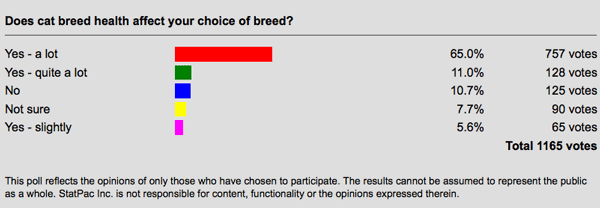From the standpoint of inheritable diseases the Maine Coon is healthier than the flat-faced Persian. Both are popular breeds. I believe this is worth knowing because most purebred cat adopters consider the health of the cat important.


You are in the mood to adopt a cat and you fancy a purebred cat. Two of the most popular are the Maine Coon and the modern (flat-faced) Persian. A major influence in deciding between these breeds is whether there are any health issues associated with the breed due to genetic inheritance.
All things being equal, individual cats vary in their general health. The same goes for people. You can’t predict how an individual cat’s health will turn out.
However, because purebred cats are deliberate bred, mainly for appearance, they tend to develop inherited health traits because certain recessive genes which create health problems and which are normally kept dormant are pushed to the front and became active. It is a potential side-effect of controlled inbreeding for appearance.
Bearing that in mind, it is possible to compare breeds in terms of a potential to develop an inherited disease. This potential may never occur but it is still there and should be one of the things a person considers when deciding between two or more breeds that she fancies adopting.
It does not mean that all Maine Coons are healthier than the Persian. It just means that, in general, the Maine Coon is potentially more healthy. My guess is that if you compared ten pairs of cats, the Maine Coon would be more healthy in seven cases.
A point worth raising is whether the traditional Persian is more healthy than the flat-faced variety (see a full page on Persians). The answer should be yes even if we only refer to tear overflow, which is symptomatic of the flat face. As for PKD1, I am not sure of the difference in incidence of this disease with reference to traditional and modern Persians but it is high.
Note: the lists of potential diseases are quite extensive. Some will be rare or even very rare; others not so. An adopter should not be obsessed about these diseases but simply aware of them.


Michael: I wonder if the GCCF have regrets about what happened with the Persian. I’m unclear what they mean by “natural morphologies” in section 2.4 of their breeding policy, but I did wonder if they had the Persian in mind.
I do think UK Persians are less extreme looking than their American counterparts. This may be because the GCCF is the only registry to specify in their points of standard that judges can withhold points if “The upper edge of the nose leather is above the lower edge of the eye.” My concern is that judges who favour the extreme look may decide not to withhold points. It is after all their interpretation of the breed standard which changed, resulting in breeders producing flatter faced cats in order to win titles.
I may be wrong, but I have the impression that in the UK the Chinchilla Persian seems to retain more of the traditional face than other colours within the breed.
I’m sure campaigns like those here on PoC to put health first, are having an effect on the buying public. Without access to this information, they wouldn’t necessarily be aware of those health concerns associated with the Persian and many other breeds.